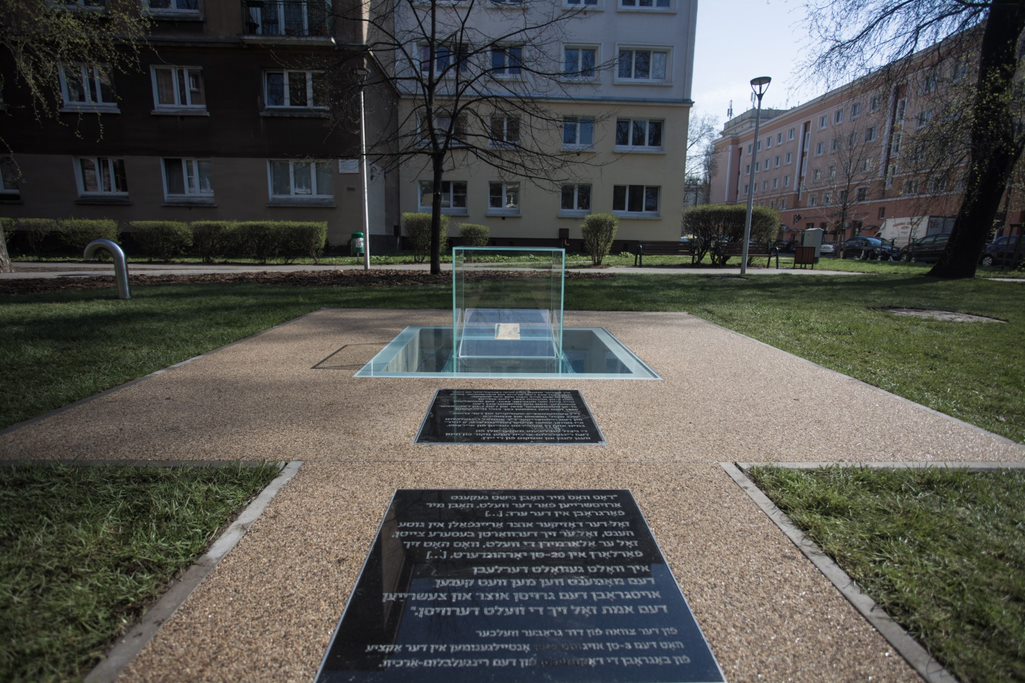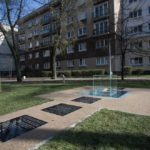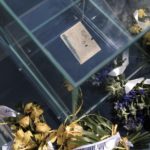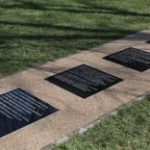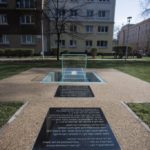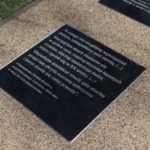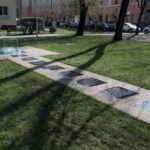On April 19, 2021 the monument commemorating the Oneg Shabbat group was unveiled at Nowolipki 28 in Warsaw. The Ringelblum Archive Commemoration Monument, designed by Łukasz Mieszkowski and Marcin Urbanek, emerged on the map of Warsaw thanks to the partnership of the Association for Social and Cultural Initiatives Stacja Muranów, the Association of the Jewish Historical Institute of Poland, the Public Committee for the Ringelblum Archive Commemoration, over 40 donors from Poland and around the world, and many other people who did their utmost to properly commemorate the heroes of Oneg Shabbat.
THE IDEA BEHIND THE MONUMENT
From the creators:
We wanted the memorial to be modern and minimalistic, an abstract and yet a clearly intelligible symbol.
The cube, made out of architectural glass, rests on a glass cover over an opening in a chamber ceiling. The chamber, made out of architectural concrete, is supposed to symbolize the interior of a cellar, but its modern appearance clearly signals that this is not the original, historic space. The cover makes it possible to safely look inside the chamber, while by holding up the cube it gives the impression that the latter is rising from the dark shaft in the floor out into daylight. The cube is also where we propose to place a photocopy of Graber’s last will – a material artefact symbolic of the typewritten material, printed leaflets and posters in the Ringelblum Archive.
In order to ensure that no other shape competes with the bright glass cube rising from the ground we have placed the commemorative text on granite plaques distributed so as to lead visitors to the memorial.
Łukasz Mieszkowski
Marcin Urbanek
creators
DONORS
The project was supported by over 40 donors from around the world – Poland, USA, Israel, among others.
Full list of donors can be accessed here.
BACKGROUND
The story began on a Saturday. In the autumn of 1940, several people living in the Warsaw ghetto began to meet on a regular basis to collect and prepare broadly understood documentation detailing the plight of Polish Jews under the German occupation. At the time they didn’t yet know that the mass persecution of their people would eventually become mass extermination, and that the task they had undertaken would give rise to the most important testimony of the Holocaust. They met on Saturdays and so adopted the name Oneg Shabbat which means Joy of the Sabbath in Hebrew.
They met in the building at ul. Tłomackie 3/5 which housed the Main Judaic Library and the Institute of Judaic Studies, right next to the Great Synagogue. Today, that very same building – belonging to the Association of the Jewish Historical Institute of Poland and housing the Emanuel Ringelblum Jewish Historical Institute – is where the Ringelblum Archive is kept.
Emanuel Ringelblum became the leader of the underground organization. The ‘brotherhood’ brought together people from various social spheres and professional backgrounds: journalists, writers, teachers, economists, entrepreneurs, craftsmen, students — people with different views and interests whose overarching goal was to convey a complex and comprehensive image of Jewish life during the war.
Each member had an assigned task. Some of Ringelblum’s collaborators dealt with documentation and registration, others collected accounts and edited or annotated them. Others yet followed the daily lives of the ghetto inhabitants. There were also those who contributed academic papers, personal journals, or literary works.
The archive includes the accounts of many anonymous individuals. The contributors’ address list compiled by Hersz Wasser features both the names of the closest collaborators of the Oneg Shabbat as well as those of family members and persons about whom nothing is known (the latter are probably unidentified authors and copyists).
Of the authors known by their first and last names only three survived the war: Hersz Wasser —Ringelblum’s secretary, Wasser’s wife Bluma, and Rachela Auerbach. It was thanks to Wasser’s indications that the first part of the archive was unearthed in September 1946 on ul. Nowolipki. The second cache was found by accident in December 1950.
The members of the Oneg Shabbat risked their lives daily, employing all means at their disposal to leave a testimony of themselves, their community, and their shared suffering for the outside world and for a different age. It was a mission. For many the obligation proved more powerful than the desire to save themselves.
COMMITTEE FOR THE CONSTRUCTION OF THE RINGELBLUM ARCHIVE MEMORIAL
The idea and design of the Ringelblum Archive Memorial at the site where it was hidden emerged in 2009 in the minds of Marcin Urbanek and Łukasz Mieszkowski, inspired by a lecture by Prof. Jacek Leociak. In 2015, a grassroots Committee for the Construction of the Ringelblum Archive Memorial was established in Warsaw.
Łukasz Mieszkowski — visual artist and historian. He specializes in book illustration, comic books, and exhibition and architectural design. In addition to the Ringelblum Archive Memorial, he is the author – along with Marcin Urbanek and Piotr Michalewicz – of the museum and memorial at the former Nazi extermination camp in Sobibór. Author of the book Tajemnicza rana — mit czołgu w powstaniu warszawskim (Mysterious Wound: The Myth of the Tank in the Warsaw Uprising). He defended a PhD thesis entitled Smoki i wszy. Polska w czasie zarazy 1918-1922 (Dragons and Lice: Poland during the Epidemic of 1918-1922) at the Historical Institute of the Polish Academy of Sciences. A friend of the Forum for Dialogue, co-founder of the Committee for the Construction of the Ringelblum Archive Memorial.
Marcin Urbanek – architect. Along with Łukasz Mieszkowski he is the originator of the idea and author of the design of the Ringelblum Archive Memorial. Co-author of the Chopin Museum in Warsaw, the reconstruction and renovation of ROMA Musical Theatre in Warsaw, the Museum and Memorial in Sobibór, and the temporary exhibition Luther in Gdynia at the Gdynia City Museum. Author of the monument to the Second Polish Army in Poznań.
Beata Chomątowska – journalist, president of Stacja Muranów association, the author of several books (her last book, Betonia, was nominated for the Gdynia Literary Prize), co-author of the temporary exhibition about Muranów prepared by POLIN Museum.
Łukasz Prokop – co-founder and vice-president of Stacja Muranów association, where he has implemented several urban and cultural projects. Social activist and initiator of several Warsaw murals (including the depictions of Zły, David Bowie and Ludwik Zamenhof). Originator of the grassroots photo archive Muranoteka.pl, co-founder of the Ringelblum Archive Memorial Committee. Educated as a political scientist and advertising specialist. His interests include Warsaw, street art, and design. He manages Stacja Muranów on a daily basis.
Aleksandra Engler-Malinowska – culture manager and PR specialist. Graduate of the University of Warsaw Management Department and of the Theatre Academy in Warsaw Theatre Studies Department. National coordinator of the project Transport 77 whose aim is to teach young Europeans about the Holocaust. The project is affiliated with the Mémorial de la Shoah in Paris and its partners in Poland are the Ministry of National Education, the Emanuel Ringelblum Jewish Historical Institute, and POLIN Museum of the History of Polish Jews. She worked at POLIN Museum for several years as a permanent exhibition guide. She has also collaborated with the Association of the Jewish Historical Institute of Poland, the Taube Center for the Renewal of Jewish Life in Poland, the Polish Press Agency, and others. She is especially proud of her collaboration with the Lech Walesa Institute as a liaison officer to the 14th Dalai Lama during the Peace Summit of Nobel Prize Laureates in Warsaw. She was involved in promoting Wojciech Smarzowski’s film Róża at the Toronto International Film Festival, and she assisted the makers of Roberta Grossman’s Who Will Write Our History in Poland.
Originator and coordinator of the Stacja Pomarańczarka project and mural in Falenica. Coordinator of activities linked to the Ringelblum Archive Memorial project on behalf of Stacja Muranów. Member of Stacja Muranów association.
Tomasz Kapliński – lawyer. He has been running his own law firm for several years. Co-founder and board member of the non-governmental organization 61 whose goal is to monitor the implementation of the electoral programs and promises of legislative and executive bodies in Poland and whose findings are published on the website www.mamprawowiedziec.pl. Involved in the work of the Warsaw and Polish bar, he served a judge of the Higher Disciplinary Court for the Bar for many years. He is involved in Polish-Jewish dialogue and supports and collaborates with the Forum for Dialogue. He is a member of the Committee for the Construction of the Ringelblum Archive Memorial.
More about the Committee on the website of Stacja Muranów:

